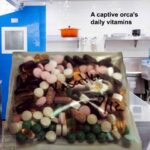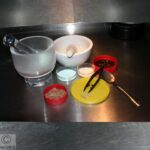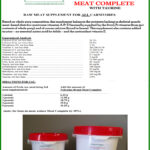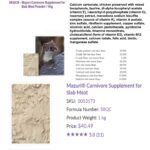Should I Add Vitamins To The Diets Of The Wildlife I Care For And If So Which Ones?
For thoughts on that, go here.
Throughout my career I have learned to trust product produced by Mazuri. If you are feeding an animal a Mazuri diet, you are already getting all that wildlife veterinarian nutritionists know about the vitamin and other nutrient needs of that animal. So giving that animal a vitamin supplement could do more harm than good, particularly when it comes to the fat-soluble vitamins A and D. The problem with making unnatural wildlife’s diet nutritionally adequate with vitamin supplements, is that although they save you time and money, they do not introduce you animals to the natural sources of the nutrients they will encounter once you release them. Zoos aren’t going to let their display animals go. Their carnivorous animals generally do well when they use Nebraska Packers Meat Complete or Mazuri’s carnivore supplements.
People who tend to scientific terms call birds that eat only seeds granivores. The seeds these birds consume is first soften and digested in their fore stomach or proventriculus by the hydrochloric acid and pepsin enzyme secreted there. It then moves a bit farther down their digestive tract into their muscular gizzard (their ventriculus ) where it comes into contact with grit and the gizzard’s strong muscles. A churning back and forth action occurs before the grains pass farther down the tract for absorption.
Other birds were designed by Nature to eat primarily fruit (frugivorus) or insects (insectivores). Both also tend to have a well-developed gizzard – either to help them grind the tough fiber that wild fruit and seedpods contain or to pulverize the chitinous shells of insects and the aquatic crustaceans they consume.
The two largest protein reservoirs in birds are its feathers and its muscle. Feathers compose about 4-6% of a live bird’s weight or about 22-28% of its total body protein. It differs between species with birds capable of long flight having the greatest feather to body weight ration. Feathers are particularly rich in cysteine, which, along with other amino acids must be continually supplied to growing and molting birds. When it is lacking, either due to the poor appetite of health issues, inappropriate diet or starvation, the most obvious sign you will see are stress bars on the bird’s feathers.
Raptors and owls do not have well-developed gizzards. Hawks and eagles retain much of their recently consumed prey in their lower esophagus, which serves as their crop. From there it slowly moves down to their glandular stomach for digestion. Indigestible portions are brought back up (regurgitated) as casts. Owls do not have this esophageal/crop-like compartment. So their food moves directly to their glandular stomach. Some believe that the lack of that compartment makes owls less efficient in digesting the food they consume.
Cultivated seeds tend to be higher in carbohydrates and lower in protein than the wild grains from which they were developed. Cultivated sees such as sunflower and safflower seeds are also considerably higher in fats and oils than their wild ancestors. These seeds also tend to be deficient in vitamin A, mineral, fiber and total protein and specific amino acids. ( read about that here & here ) These domesticated varieties also tend to contain fewer antioxidants, less bitter taste.
When it comes to meat-eating birds and mammals, domesticated livestock and poultry as provided by wildlife rehabbers as enormously more fat than wild prey animals these creatures normally consume. Although the raptors I care for reject domestic poultry from which the fat has not been removed, some animals are attracted to these high grease diets that are harmful to them. ( read about that here )
Even after pealing off all the fat and skin, chicken breast still has 4 gm of fat /100 gm of meat while that of a wild dove 1.8 grams and wild turkey 1.1 grams respectively.
Birds in particular are creatures of habit. Once accustomed to a homogeneous shape, size, taste and color, it can be quite difficult to get them to accept new food items.
The Fat Soluble Vitamins
These four vitamins dissolve in oils and fats. So for wildlife to obtain adequate absorption of these vitamins from their diets, those diets need to contain a minimum of 1.5 % fat when herbivorous animals are fed. In commercially prepared diets, that is often in the form of soybean oil. The fat content of carnivore diets it is much higher. In many carnivore diets is a minimum of 20%. That is not done to increase fat soluble vitamin absorption. It is because their metabolic need for dietary fat is much greater.
Vitamin A
Vitamin A is one of the four fat soluble vitamins. Fruit, berry and plant eating mammals and birds or those that include them in a mixed diet (omnivores) are efficient in converting the Beta-carotenes (pro-vitamin A compounds) found in plants into vitamin A. Those that eat primarily meat or fish are less efficient in doing so. Spinach, broccoli, squash, Alfalfa are among the vegetables with substantial amounts of beta-carotene. Grains are much lower in carotenoids when compared to the levels found in brightly colored fruits and vegetables with sunflower seeds, millet and peanuts being exceptionally low in this vitamin. Dog food relies on added carotenoids to provide dogs with these pro-vitamin A compounds. But since all felines have lost the ability to convert carotenes into vitamin A, cat food relies on the addition of liver that is rich in vitamin A to meet feline needs. Liver and egg yolks are rich in pre-formed vitamin A. Vision problems and an increases susceptibility to respiratory tract infections have been associated with a vitamin A deficiency. Vitamin A is necessary to maintain healthy air sac, lung and digestive tract linings. So some associate an increased risk of aspergillosis in raptors and other birds with diets deficient in vitamin A. Preen gland impactions and lack of preen gland feather oils in raptors have also been associated with a vitamin A deficiency.
The heat of factory processing of commercial animal diets destroys a sizable amount of the vitamin A added to diets so it is usually added in excess. However, fortified wheat and cornflower stored at room temperature for six months retains over 95% of the vitamin A that was initially added. Vitamin A is stored in the animal’s liver. Receiving too much vitamin A is one of the causes of liver destruction. Another affect of long-term excessive vitamin A is joint problems and arthritis. The most common cause in captive wildlife is being fed too much organ meat. But occasionally occurs when mistakes are made in factory-produced animal diets. It also occurs when reptiles are suspected of hypovitaminosis A (= too little A) and given excessive amounts of multivitamins in an attempt to cure it. While plant-eating turtles like red-eared sliders are capable of synthesizing vitamin A from the carotenoids in the plants they eat, meat-eating turtles and box turtles are less efficient at doing so.
Vitamin E
Vitamin E exists as eight similar tocopherols. Vitamin E is an antioxidant that helps protect the cells of all animals from destructive oxidation metabolites formed during normal metabolism in all animals. Diets fed at wildlife rehabilitation centers are unlikely to be deficient in vitamin E because it is found in adequate amounts in eggs, vegetable oils, nuts, sweet pepper, turnip greens. Fish that are fed to captive wildlife are often the ones that sat too long on the dock. As the oils in those fish become rancid, Vitamin E in them is destroyed. When you see tocopherols as an ingredient in commercial animal feeds it is there in larger than needed amounts to act as an antioxidant preservative. Too much vitamin E in diets can be one of the underlying causes of bleeding as the vitamin also has anti-blood clotting properties. Insufficient dietary vitamin E is known to cause white muscle disease in woodchucks and deer, particularly when their consumption of selenium is also low. Because vitamin E enters the animal’s body dissolved in fat, diets too low in fat and oils magnify vitamin E deficiencies. That is thought to occasionally cause E-deficiency signs in raptors.
Vitamin D
Vitamin D is another fat soluble vitamin. It is a regulator of the body’s calcium and phosphorus content – the important minerals that make up bone, aiding in the absorption of calcium through the intestine. Humans, rodents, horses, cattle, pigs and sheep can synthesize all the vitamin D they require from cholesterol. Which wildlife can and which cannot produce sufficient Vitamin D on their own remains unknown. The lack of vitamin D is a common cause of rickets that occurs across the animal kingdom. To produce vitamin D, light provided to animals should be artificial full spectrum or natural sunlight. We humans can survive on vitamin D 2. But most animals require theirs to be vitamin D 3. Egg yolk is a particularly good source of vitamin D3. Carnivorous saltwater fish (high on the food chain) are also a good source, but tilapia contains sizable amounts of vitamin D3 as well. Forty minutes of normal cooking temperatures destroys about a third of the vitamin D originally present in dietary ingredients. Too much vitamin D intake is also toxic.
It may not only be thiaminase that is a risk factor when birds and mammals are fed fish. A 2020 report from a California bird rescue center found a possible association of leg fractures in herons and egrets with their switch from feeding herons and egrets primarily smelt in 2017 to capelin in 2018. They also received Mazuri’s Auklet supplement, which contains plenty of thiamine – but no vitamin D3. The report has limitations. The authors didn’t measure the vitamin D3 content of the capelin to confirm that it was low or if the birds with this problem had low vitamin D3 levels. They also did not reported if the problem resolved when the bird’s diet was altered to a different fish(es) in following years. Too rapid a growth rate can also result in similar leg abnormalities.
Vitamin K
Vitamin K deficiencies are not a problem in wildlife – unless they have consumed dying rodents that consumed anticoagulant rodent baits ( eg brodifacoum or bromadiolone. In those cases, injections of menadione occasionally saves them. Natural vitamin K deficiencies are rare because normal bacteria present in the intestines of birds and mammals produce sufficient amounts of vitamin K. Like the other fat soluble vitamins, vitamin K requires fat or oil to be present in the animal’s intestine for it to be absorbed.
The Water Soluble Vitamins
Vitamin C
Vitamin C ( ascorbic acid ) is a water soluble compound. Vitamin C is involved in tissue growth and repair, and also functions as an antioxidant to block damage caused by free radicals. Most animals manufacture their own vitamin C from the glucose or galactose present in their bodies. The conversion occurs in their liver or kidneys depending on species. All animals require it but only us humans, bony fish, monkeys, guinea pigs certain birds and new world bats have lost the ability to synthesize it. Geese, swans, owls, coots, pigeons, sparrows, birds of prey, herons, crows and ravens are among the birds that synthesize their own vitamin C. Whereas, shrikes, flycatchers, swallows and warblers appear to have lost that ability. Read more about that here. Unfortunately vitamin C is a very fragile vitamin that is easily oxidized and destroyed. It is also easily destroyed by heat and sunlight. That is why commercial diets for animals that cannot produce their own vitamin C should not be stored for more than a month or two.
The B Vitamins
Wildlife like deer, woodchucks and rabbits that subsist primarily on plants are particularly susceptible to water soluble vitamin deficiencies in their pre-weaning period. That is because as they are in the process of shifting their diet from their mother’s milk to their rumen or cecal bacterial digestion, the bacterial fermentation in those organs is not great enough to supply their vitamin needs which are still very high do to their rapid growth. When purchased, they are generally sold in a mixture that contains all of them and is labeled B-complex.
Vitamin B 1 (aka Thiamine)
Vitamin B-1 or thiamine is a water soluble vitamin. It is required for nerves to function properly. So many foods containing animal and plant ingredients contain B1 that a lack of it has never been reported to occur in wildlife. However, some fish fed to fish-eating birds and mammals at zoos and wildlife rehabilitation facilities contain thiaminase and enzyme that destroys thiamine. Raspberries, blackberries and cherries are also reported to contain thiaminase – but if there is enough of it to be of any consequence to wildlife consuming them remains unknown. In animals that consume primarily grass and plant roughage, a thiamine deficiency has been associated with feeding too rich a diet. Concentrated diets are thought to inhibit the bacteria in the digestive tract that would normally produce thiamine. Thiaminase is an enzyme that can lead to a thiamine deficiency. Until that was discovered in the 1970s, lack of thiamine was a common cause of seizures in the captive and rehabilitating sea lions I dealt with. At the time, it was also the cause of paralysis and seizures in fur ranched fox, mink and otters. In those situations it was called Chastek paralysis. That is the reason that Marine parks and aquaria heavily fortify their marine mammal diets with large amounts of thiamine and other vitamins. Generally large amounts of vitamin E are given as well because as fish spoil on the dock they liberate unhealthy free radicals . The spoilage process in these fish is called lipid peroxidation . The capsules and tablets are inserted in fish and tossed by a good pitcher to specific animals. Low end of the market fish that are sold to zoos and rehab centers – fish like anchovies, butterfish, capelin and herring – are at a high risk of spoilage before you receive them. If they are not packed in ice within 4 hours of their netting, bacteria begin to break down the histidine amino acids within them into toxic histamine and biogenic amines. These unwanted changes can result in scombrotoxin poisoning .
Vitamin B 2 (aka Riboflavin)
Vitamin B 2 is only present in small amounts in seeds. So deficiencies are primarily seen in birds and small mammals that subsist primarily on seeds or corn or are fed diets in which a major ingredient is unsupplemented soybean meal. In birds, the primary symptom is leg weakness (curly toe paralysis). In mammals the signs are incoordination, trembling and muscle weakness. Some also report exaggerated reactions to sudden noises or touch (hyperesthesia). Brewers yeast is an excellent source of riboflavin/B 2.
The Vitamin B 3 Family (Niacin, Nicotinic Acid and Nicotinamide )
Like vitamin B 2, the forms B 3 vitamin family that occur in plants are low in availability. So diets that rely a lot on corn ingredients tend to be low in them unless they are supplemented with B 3s. The signs of a niacin deficiency are the same as for a riboflavin deficiency and if either occurs, the other is probably deficient in the diet you are feeding as well. Like all of the water soluble vitamins, animals do not have the ability to store these vitamins. So symptoms of a deficiency occur rather quickly. The two readily available food sources for wildlife rehabilitators that naturally contain the most niacin are liver and chicken. However the heating involved in processing destroys much of it. Some believe that avian species differ in the amount of B 3 vitamins they require based on their ability to internally convert tryptophan into niacin. Egg white is one of the best sources of tryptophan.
Vitamins B 5 (aka Pantothenic acid) vitamin B 6 (aka Pyridoxine) and vitamin B 9 (aka Folic acid)
Deficiencies in any of them or all of them all result in retarded growth and produce symptoms indistinguishable from deficiencies in the other B vitamins already mentions. And like the other B vitamins, “Good” bacteria present in the digestive tract of healthy mammals and birds have the ability to manufacture a portion or all of them that are required.
Vitamin B 12 (aka Cobalamin)
Vitamin B 12 is also produced by intestinal bacteria. But not in amounts sufficient to fulfill a carnivorous animal’s needs. In those species, organ meat (entrails), liver and, to a lesser extent eggs, are good sources of vitamin B 12. Plant-consuming animals like deer and rabbits obtain all the B 12 they need because the bacteria and other organisms (archaea) in their complex stomachs or cecum produce sufficient amounts. There is little or none in the plants they eat. Fish eating birds and mammals obtain it because the fish they eat somewhere along the food chain consumed phytoplankton that consumed vitamin B-generating aquatic bacteria.
So vitamin B 12 deficiencies in nature are uncommon. I only know of it having occurred in areas where the soils were deficient in cobalt. Cobalt is a necessary ingredient in the formation of vitamin B 12. However in wildlife rehabilitation situations those important bacteria might be lost. For instance, the animal you are feeding might need antibiotics. Those antibiotics kill the good as well as the bad bacteria for which you gave them. Or, perhaps the animal had diarrhea or intestinal inflammation due to a high parasite load. Veterinarians give B 12 injections to dogs and cats as an appetite stimulant. When dogs and cats aren’t eating, they are not ingesting enough B 12 and the thought was that administering it might make those pets more likely to want to eat. As is the case with a lot of vitamin gossip, no one has proven that one way or the other. But in the amounts given, these injections are harmless. I have never know of vitamin B-12 alone being given to wildlife. But as it is non-toxic when the recommended human dose is scaled down to the animals weight and perhaps there is a place for it.




